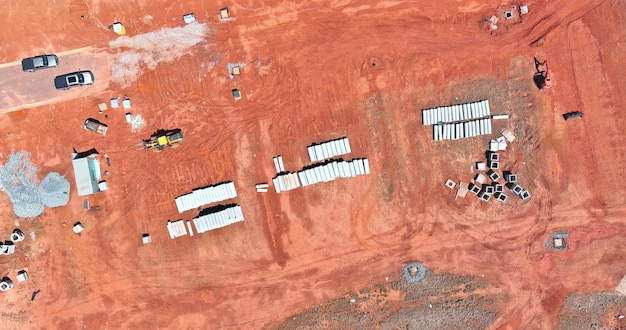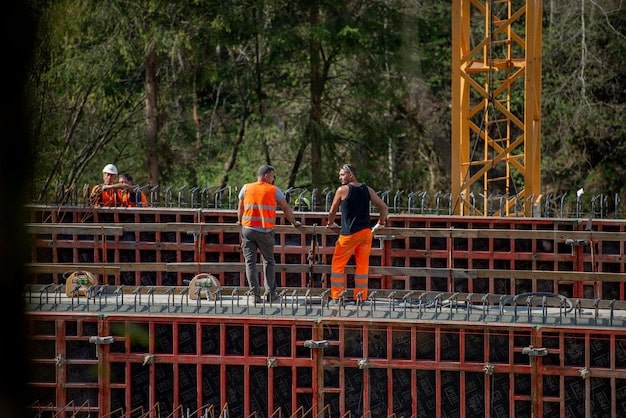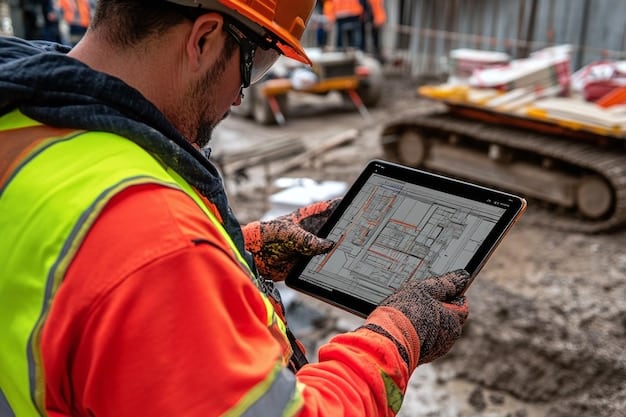Infrastructure Bill: Construction Business Opportunities in the US

The New Federal Infrastructure Bill is set to create significant opportunities for US construction businesses, driving growth and innovation across various sectors.
The New Federal Infrastructure Bill represents a historic investment in America’s infrastructure, unlocking unprecedented opportunities for US construction businesses to thrive and expand.
Decoding the Infrastructure Bill: A Primer for Construction Firms
The Infrastructure Investment and Jobs Act (IIJA), commonly known as the Infrastructure Bill, is a comprehensive piece of legislation that promises to reshape the American landscape. For construction businesses, understanding the key provisions of this bill is crucial for strategic planning and resource allocation.
This section will delve into the core elements of the bill, highlighting the sectors that will receive the most significant funding and the types of projects that are expected to be prioritized. We’ll break down the complexities of the bill into digestible information, providing a roadmap for construction firms to navigate the opportunities ahead.
Key Investment Areas
The Infrastructure Bill targets several key areas for investment, each presenting unique opportunities for construction businesses:
- Transportation: Roads, bridges, and public transit systems will receive substantial funding for repair and modernization.
- Water Infrastructure: Investments in water pipes, treatment plants, and dam safety projects aim to ensure clean and reliable water access.
- Broadband Internet: Expanding access to high-speed internet in rural and underserved areas requires significant infrastructure development.
- Energy Grid: Modernizing the power grid and investing in renewable energy infrastructure are critical components of the bill.
These are just a few of the many sectors that will benefit from the Infrastructure Bill, creating a diverse range of projects for construction companies to bid on and execute. Understanding these key investment areas will allow businesses to strategically position themselves for success.

Strategic Planning: Positioning Your Business for Success
With the landscape of construction projects set to change, strategic planning is paramount for construction businesses. Assess your company’s strengths and capabilities, and identify the areas where you can best contribute to the infrastructure development efforts.
Consider partnerships and collaborations to expand your reach and expertise. Develop a comprehensive marketing strategy to showcase your company’s capabilities to potential clients and government agencies. By proactively planning and adapting, you can maximize your chances of securing valuable contracts and driving long-term growth.
Assessing Your Company’s Capabilities
Before diving into the bidding process, take a hard look at your company’s strengths and weaknesses. Ask yourself:
- What types of projects are we best suited for?
- What resources do we have available, including personnel and equipment?
- Where do we need to improve our skills or expertise?
Building Strategic Partnerships
Consider forming partnerships with other construction firms, engineering companies, or technology providers to expand your capabilities and bid on larger projects. Strategic alliances can bring in specialised knowledge and resources that may be missing in your company.
By carefully evaluating your current status and creating strategic advantages, you can optimize your chances for success in this new era. This proactive approach increases competitiveness and creates a solid base for long-term growth.
Navigating the Bidding Process: Securing Infrastructure Projects
The bidding process for infrastructure projects can be competitive and complex. Understanding the specific requirements of each project, developing strong proposals, and building relationships with key decision-makers are essential for success.
This section will provide practical guidance on navigating the bidding process, from identifying potential projects to submitting compelling proposals that highlight your company’s qualifications and expertise. We’ll also discuss the importance of compliance and ethical conduct in the bidding process.
Crafting a Winning Proposal
A well-crafted proposal is crucial for standing out from the competition. Your proposal should clearly articulate your understanding of the project requirements, your proposed approach, and your company’s qualifications.
Highlight your company’s experience with similar projects, your commitment to safety and quality, and your ability to deliver on time and within budget. Showcase the unique value proposition that your company brings to the table, and demonstrate your commitment to exceeding expectations.
Building Relationships with Key Decision-Makers
- Attend industry events and conferences to network with potential clients and partners.
- Participate in community outreach programs to demonstrate your commitment to local development.
- Seek out opportunities to meet with government officials and project managers to learn about upcoming projects and priorities.
Complying with Regulations and Ethical Standards
Always adhere to all applicable regulations and ethical standards throughout the bidding process. Transparency, honesty, and integrity are essential for building trust and maintaining a positive reputation.
Technology Adoption: Enhancing Efficiency and Productivity
Embracing new technologies can significantly enhance efficiency and improve cost-effectiveness for construction businesses. From Building Information Modeling (BIM) to drone surveying and AI-powered project management tools, technology can streamline operations, reduce errors, and improve decision-making.
This section will explore the different technological advancements that are transforming the construction industry and provide guidance on how to effectively integrate these tools into your business. By adopting technology, you can gain a competitive edge and deliver projects more efficiently and effectively.
Cutting-Edge Technologies Transforming Construction
Construction firms are increasingly leveraging technologies such as:
- Building Information Modeling (BIM): BIM creates detailed 3D models of construction projects, allowing for better collaboration, clash detection, and project planning.
- Drones and Robotics: Drones can be used for surveying, site monitoring, and progress tracking, while robots can automate repetitive tasks such as bricklaying and welding.
- Artificial Intelligence (AI): AI algorithms can analyze project data to identify risks, optimize schedules, and improve decision-making.
- Wearable Technology: Wearable devices such as smart helmets and exoskeletons can improve worker safety, productivity, and communication.
Integrating these technologies can result in the improvement of efficiency, precision, and overall project results. Companies that embrace these opportunities can reduce costs while improving the quality of their work.

Workforce Development: Addressing the Skilled Labor Shortage
One of the biggest challenges facing the construction industry is the shortage of skilled labor. With the influx of new infrastructure projects, the demand for qualified workers will only increase. Addressing this shortage requires a multi-faceted approach that includes investing in training programs, attracting new talent to the industry, and retaining existing employees.
This section will explore strategies for workforce development, including apprenticeships, vocational training, and partnerships with educational institutions. We’ll also discuss the importance of creating a positive and inclusive work environment to attract and retain top talent.
Investing in Training and Apprenticeships
To address the skilled labor shortage, the construction industry must invest in:
- Apprenticeship Programs: Provide on-the-job training and classroom instruction to develop skilled craft workers.
- Vocational Training: Partner with vocational schools to offer specialized training in key construction trades.
- Upskilling Initiatives: Offer training programs to help existing employees upgrade their skills and adapt to new technologies.
Creating an Inclusive Work Environment
Promoting diversity, equity, and inclusion in the workplace can attract a wider range of talent and create a more positive and productive work environment. By establishing standards of equality, an attractive and inclusive setting can be built for workers with talent from all backgrounds.
Sustainability and Green Building: Embracing Eco-Friendly Practices
Sustainability is becoming an increasingly important consideration in infrastructure projects. Incorporating green building practices, using sustainable materials, and reducing carbon emissions can not only benefit the environment but also enhance your company’s reputation and competitiveness.
This section will explore the trends in sustainable construction, including the use of recycled materials, energy-efficient designs, and water conservation measures. We’ll also discuss the incentives and regulations that are driving the adoption of green building practices in the infrastructure sector.
Trends in Green Building Practices
Construction businesses are increasingly adopting sustainable practices such as:
- Using Recycled Materials: Incorporating recycled concrete, steel, and other materials to reduce waste and conserve resources.
- Implementing Energy-Efficient Designs: Optimizing building designs to reduce energy consumption and carbon emissions.
- Conserving Water: Using water-efficient fixtures and landscaping techniques to minimize water usage.
Furthermore, there is a movement towards constructing Leadership in Energy and Environmental Design (LEED) certified buildings to have the construction projects validated by trusted, globally recognized standards.
| Key Point | Brief Description |
|---|---|
| 💰 Funding Overview | Billions allocated to transportation, water, broadband, and energy sectors. |
| 🤝 Strategic Planning | Assess company capabilities and build partnerships for larger projects. |
| ⚙️ Tech Adoption | Implement BIM, drones, AI for efficiency and precision. |
| 🌿 Sustainability | Use recycled materials and energy-efficient designs for sustainability requirements. |
FAQ
▼
The Infrastructure Investment and Jobs Act (IIJA) is a federal law that provides significant funding for infrastructure development and improvement across the United States, focusing on transportation, water, broadband, and energy sectors.
▼
The bill creates numerous opportunities for construction businesses by funding a wide range of projects, from repairing roads and bridges to expanding broadband access and modernizing the energy grid.
▼
Key areas of investment include transportation (roads, bridges, public transit), water infrastructure (pipes, treatment plants), broadband internet expansion, and modernization of the energy grid.
▼
Technologies such as Building Information Modeling (BIM), drones, Artificial Intelligence (AI), and wearable devices can enhance efficiency by streamlining operations, reducing errors, and improving decision-making.
▼
Companies can address the shortage by investing in apprenticeship programs, vocational training, upskilling initiatives, and by creating a positive and inclusive work environment to attract and retain talent.
Conclusion
The Infrastructure Bill represents a transformative opportunity for US construction businesses. By understanding the bill’s key provisions, developing strategic plans, embracing technology, and prioritizing workforce development and sustainability, construction firms can position themselves for long-term success and contribute to rebuilding America’s infrastructure.





